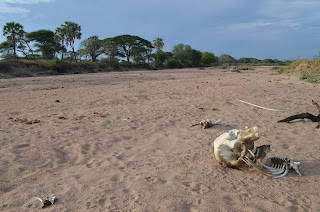 |
| Thinking about a swim |
As a result of being in the middle of a massive landscape, the diversity of habitats is far less than what we were used to in the north. We're smack in the middle of a relatively homogeneous landscape and finding weekend day trips has proved to be a challenge. This is compounded by the fact that we both spend a lot of time in the field so having to get in the car to explore on the weekends isn't always the most attractive option. Still, we're new to the area so we're constantly hearing of cool spots to check out, one of which we visited this past weekend.
There are numerous rivers in the area though many are dry or have disappearing pools of water. However, some of our “neighbors” (about 15km away) told us of a waterfall they heard about so we decided to try to check it out.
We'd received some very local directions with various natural landmarks (trees, farms, etc) and we made our way along a river climbing slowly as we approached the hills to the south. The road eventually turned into a footpath and we parked the car and walked the remaining way to a waterfall.
I was actually pretty impressed with the flow of water given how dry it is but others in our party felt that attributing "waterfall" to the flow of water was unjustified. It was enough for me to jump in for a swim and the water was refreshing, bordering on being too cold! After a quick swim we decided to climb up the river, which was quite the adventure. It was somewhere between proper rock climbing and a boulder scramble. We climbed for about an hour and saw some impressive fissures of rock, beautiful views of the hills, and the highlight was probably finding the skull and horns of a kudu.
The river and waterfall were very cool and we hope to return to hike a bit more along the river downstream. Although the area is heavily impacted by humans, there is still a nice little strip of trees along the river that provide shade and good habitat for wildlife, even during the peak heat of the day. And who knows, maybe some day we'll have the energy to climb up to the source of the river?
 |
| Checking out the river |
 |
| A decent few of the landscape |
 |
| Walking along relatively flat section of rock |


















































